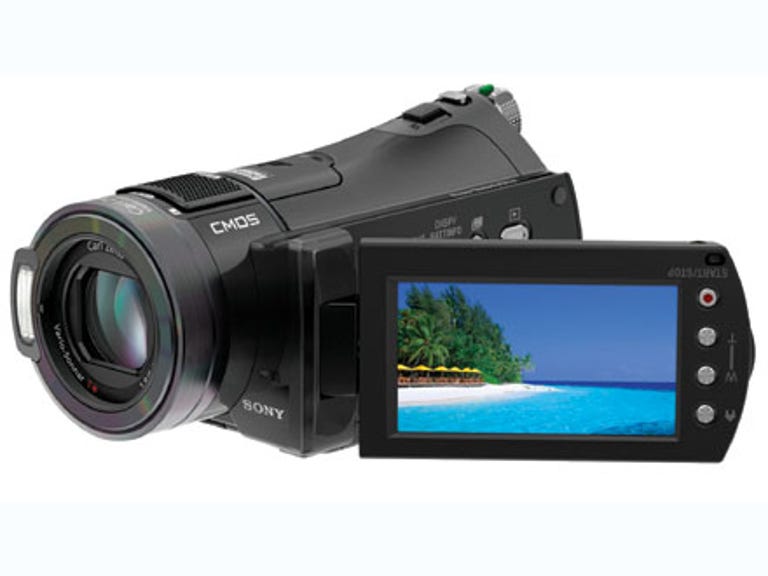 Why You Can Trust CNET
Why You Can Trust CNET Sony Handycam HDR-CX7K review: Sony Handycam HDR-CX7K
A great high-def camcorder if you intend to carry it in your handbag. If you've got a little more space, though, plump for a hard-disk model.
No sooner had we gotten our hands on the Sony Handycam HDR-CX7K, its mantle as the "world's smallest HD camcorder" was no more, with former title holder, Panasonic, releasing its latest high-def SD-card model, the SD5.
The Good
The Bad
The Bottom Line
Design
Measuring just 67mm by 67mm by 129mm and weighing 450g, Sony's HDR-CX7K is a petite little unit which can easily be thrown in handbags and backpacks alike. Unlike the Panasonic HDC-SD1 -- the model it replaced, briefly, as the "world's smallest" -- the CX7K can be handheld (relatively) steadily for long periods; this is due to the unit's upward curvature from its midway point towards the rear. In our experience, though, larger cameras are still much more comfortable to hold steady.
We've noticed that small, memory card-based camcorders feel cheaper in comparison to their hard-disk, DVD or miniDV brethren. And the CX7K's all black, all plastic body is no different in this regard because the grip area is a desert of hard, brittle plastic.
The camera's small form factor has necessitated a number of design compromises. For instance, Sony has eliminated the electronic viewfinder meaning that recording can only be done with the LCD screen flipped out. Also dumped in the quest for compactness is the manual control wheel which, given the flaws we've noticed with it on other models, is no great loss.
The main controls have also moved, with the on/off switch now sitting in a central position on the rear face of the camera. Just in front of it is the zoom toggle, which now requires a stretch of the index finger to reach. So, if you're inclined to zoom in and out while filming, be prepared for some Blair Witch-style shaky cam action.
The CX7 features the same 2.7-inch LCD touchscreen that we've seen on other Handycams, but this time the hard buttons for zoom, record and home have been relocated from their position below the screen to the left-hand side. Flipping the LCD screen out reveals a clutch of buttons for features like Nightshot and Easy Mode. Most manual settings though, like white balance and manual focus, are buried within the menu system.
Features
Output connections straight from the CX7K are limited to mini-HDMI and composite. Component, as well USB and power, sockets reside on the camera's gloss black dock. All your cabling needs are catered for except mini-HDMI, for which you'll need to pony up another AU$40 at least. Alternatively, if you've jumped on the PS3 train you can transfer your masterworks either via Memory Stick or USB for storage and viewing.
We first saw smooth slow recording on Sony's high-def mini-DVD and tape models earlier this year, and it's been included with the CX7K too. In smooth slow record mode, up to three seconds of action is slowed down to a quarter the normal speed. While it is useful for analysing golf swings, it won't be used as a special effect in home movies because footage captured in this mode is of both poor quality and low resolution.
With Face Index and Film Roll Index, Sony has made a stab at making it easier for users to find the parts of recordings that are either the most interesting or most relevant to them.
Film Roll Index is the more useful of the two, as each video is broken up into chapters of equal length -- the length of each chapter is user customisable -- and each chapter is given a thumbnail; this makes it easy to find Jenny's spectacular goal-line clearance amongst all the missed kicks and botched passes. With Face Index, each clip is catalogued by the faces of people as they appear in that clip. It's a good way of seeing who's featured in each piece of video but the face detection system is far from perfect.
Performance
Like the Sony Handycam HDR-SR7, which we happily handed an Editors' Choice award, the CX7K features a 6-megapixel ClearVid CMOS sensor with optical image stabilisation and a 10x zoom lens. Unsurprisingly we couldn't tell the difference between the two. In decent light, the CX7K's recordings featured both a pleasing crispness and good colour reproduction. When we filmed in low light a noticeable grain appeared and, although it was missing that pop-your-eyes-out-of-your-head clarity, we still found it more than acceptable. There's an in-built 5.1-channel microphone which for many will do a good enough job. Those with a more professional bent can affix an external mic via the hotshoe.
The CX7K comes bundled with a 4GB Memory Stick Pro Duo card which, according to Sony, is good for between 30 and 85 minutes of high-def recording. You'll be able to record more in standard-def but this should only be a last resort, as the step down from high-def to standard-def is quite marked.
There are a number of quality modes in both high-def and standard-def. With a keen eye and a few viewings, we could just spot the difference between the high-def modes; in higher compression video, there's some detail lost to artefacts and slightly more pixilation around areas of movement. The difference between recording modes in standard-def, though, was far more distinct with a sharp drop off in quality beyond the highest setting.
If you're truly desirous of a small, lightweight high-def camcorder which you can take anywhere, the CX7K is a good option. Footage shot will be crisp and clear but its greatest strength -- its size -- is negated by its reliance on memory cards, which limits recording time. If you can make the stretch, both with the hip pocket and with bag space, we'd suggest you go with the hard-disk based SR7 or SR8 instead.


